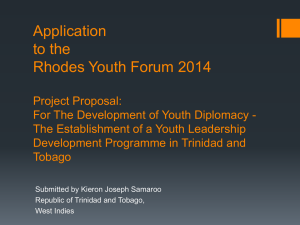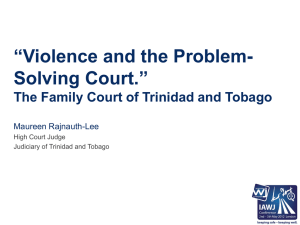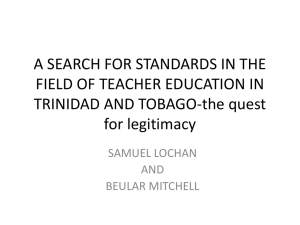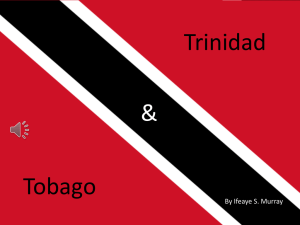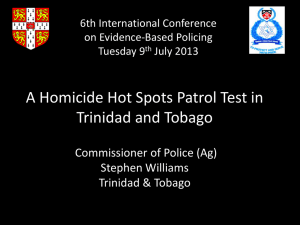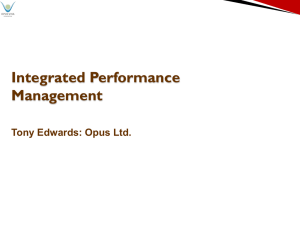An exploration of school improvement theory and practice in
advertisement
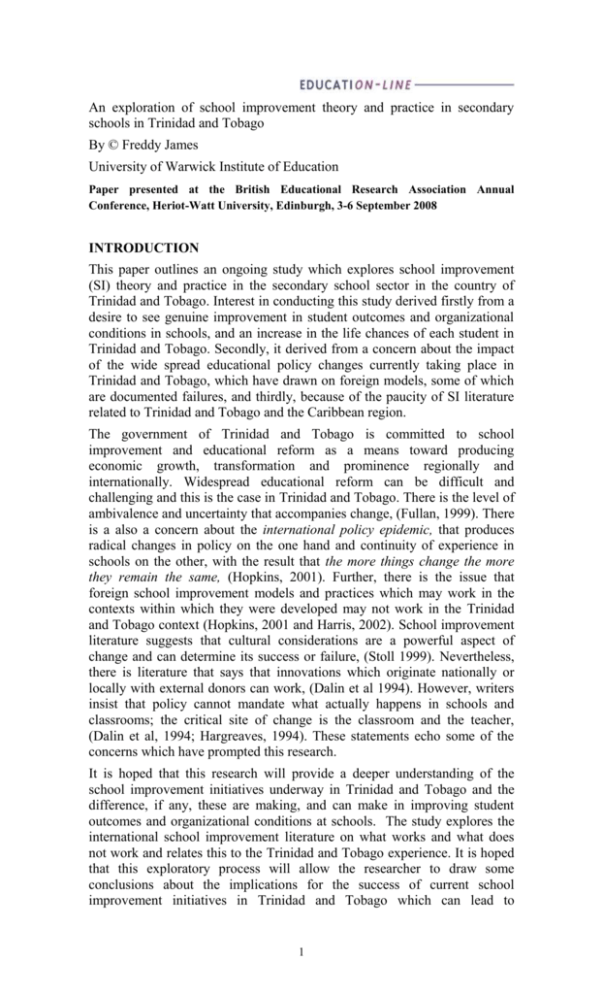
An exploration of school improvement theory and practice in secondary schools in Trinidad and Tobago By © Freddy James University of Warwick Institute of Education Paper presented at the British Educational Research Association Annual Conference, Heriot-Watt University, Edinburgh, 3-6 September 2008 INTRODUCTION This paper outlines an ongoing study which explores school improvement (SI) theory and practice in the secondary school sector in the country of Trinidad and Tobago. Interest in conducting this study derived firstly from a desire to see genuine improvement in student outcomes and organizational conditions in schools, and an increase in the life chances of each student in Trinidad and Tobago. Secondly, it derived from a concern about the impact of the wide spread educational policy changes currently taking place in Trinidad and Tobago, which have drawn on foreign models, some of which are documented failures, and thirdly, because of the paucity of SI literature related to Trinidad and Tobago and the Caribbean region. The government of Trinidad and Tobago is committed to school improvement and educational reform as a means toward producing economic growth, transformation and prominence regionally and internationally. Widespread educational reform can be difficult and challenging and this is the case in Trinidad and Tobago. There is the level of ambivalence and uncertainty that accompanies change, (Fullan, 1999). There is a also a concern about the international policy epidemic, that produces radical changes in policy on the one hand and continuity of experience in schools on the other, with the result that the more things change the more they remain the same, (Hopkins, 2001). Further, there is the issue that foreign school improvement models and practices which may work in the contexts within which they were developed may not work in the Trinidad and Tobago context (Hopkins, 2001 and Harris, 2002). School improvement literature suggests that cultural considerations are a powerful aspect of change and can determine its success or failure, (Stoll 1999). Nevertheless, there is literature that says that innovations which originate nationally or locally with external donors can work, (Dalin et al 1994). However, writers insist that policy cannot mandate what actually happens in schools and classrooms; the critical site of change is the classroom and the teacher, (Dalin et al, 1994; Hargreaves, 1994). These statements echo some of the concerns which have prompted this research. It is hoped that this research will provide a deeper understanding of the school improvement initiatives underway in Trinidad and Tobago and the difference, if any, these are making, and can make in improving student outcomes and organizational conditions at schools. The study explores the international school improvement literature on what works and what does not work and relates this to the Trinidad and Tobago experience. It is hoped that this exploratory process will allow the researcher to draw some conclusions about the implications for the success of current school improvement initiatives in Trinidad and Tobago which can lead to 1 modification, problem solving and reorganizing of the school improvement efforts if necessary. Purpose of Research The main purpose of the research is to find out what school improvement initiatives are currently underway in the secondary school sector in Trinidad and Tobago; what school improvement theory underpins these initiatives and how the initiatives relate to international school improvement theory and practice; and given the theoretical framework of the improvement initiatives, what are the implications for engendering ‘real improvement’ in: (a) student outcomes and (b) the conditions of school. The study aims to fulfil this purpose by examining what is taking place in school improvement in the secondary sector in Trinidad and Tobago, with a view to generating hypotheses and propositions about same, (DeVaus, 2001 and Yin, 2003). The following research questions were developed to realize the purpose of the study. Research Questions 1. What school improvement initiatives have emerged in the secondary school sector in Trinidad and Tobago? 2. What relations can be established between the school improvement initiatives in the secondary school sector in Trinidad and Tobago and international perspectives on theory and practice of school improvement? 3. What do these relations indicate for improvement in: (a) student outcomes and (b) organizational conditions of school? Value of the Research There is a paucity of literature on research into school improvement in the Caribbean and small island states generally. This study is significant because it can add to the existing school improvement knowledge base. Additionally, it can give Trinidad and Tobago a better understanding of what makes a difference in improving student outcomes and organizational conditions of schools in the secondary sector. As such, the results from the study can help policy makers in Trinidad and Tobago make informed decisions about reform in the secondary school sector. LITERATURE REVIEW At one level school improvement is a way of schools achieving organizational development and growth. At another level school improvement has a moral purpose and is intrinsically linked to the life chances and achievement of all students, (Harris, 2002 p. 18). Hopkins (2001) defines school improvement as a distinct approach to educational change that aims to enhance student outcomes as well as strengthening the school’s capacity for managing change. Barth (1990, p. 45) defines school improvement as, an effort to determine and provide, from within and without, conditions under which the adults and youngsters who inhabit schools will promote and sustain learning among them. According to these definitions, the purpose of school improvement is to impact ostensibly on the relationship between the teaching and learning process and the conditions that support it. Further, the change which should take place as a result of the school improvement effort should not merely reflect an implementation of policies, but rather, improvements or adaptations of practice which transform the 2 learning process to achieve the maximum impact on students, teachers and schools, (Hargreaves, 1994 and Hopkins, 2001). School improvement therefore involves some reform and educational change, which ultimately can come in various forms, (Giroux and Schmidt, 2004; Fullan, 1999 and Dalin et al, 1994). Reform efforts can be large scale, centralized, small scale, decentralized, externally initiated (by a centralized education body, or international initiatives); or internally initiated (by a single school, or school district or community). Most reform or school improvement efforts follow the agenda of some policy formulated either at the site of change, (schools), or externally by the policy makers. School improvement writers express some ambivalence about the value and success of large scale reform efforts, and externally driven initiatives, (Hopkins et al, 1999; Hopkins, 2001; Fullan, 1993; Harris, 2002 and Wang et al, 1993). Dalin et al (1994) however, states that: Both local and central initiatives work. An innovative idea that starts locally, nationally or with external donors can succeed, if programmes meet the criteria of national commitment, local capacity building and linkage, in a configuration that makes sense for the particular country. (p. 252) Chapman (2005) states that large scale and externally driven reform can work, provided that the right conditions are in existence and that the reform effort takes the singular context and cultural capacities of the school into consideration, and does not take an approach whereby schools are treated as a homogeneous group. Key School Improvement Themes There are some key themes which dominate the school improvement field, table 1.1 below, adapted from Hopkins (2001, p. 18), adequately summarizes the key themes of SI and the conditions necessary for it to occur. The principles of authentic school improvement Examples of theoretical, research, policy or practical influences on school improvement Achievement focused The moral and social justice responsibility to enhance student learning, and the unrelenting focus on the quality of teaching and learning. Empowering in aspiration The moral imperative of emancipation, of increasing individual responsibility, the enhancement of skills and confidence in the tradition of Dewey, Freire and Stenhouse. Research based and theory rich The use of teaching and learning and organisational development strategies with robust empirical support for the developing of a variety of curriculum and teaching programmes or models; and the location of the approach within a philosophical tradition e.g. Critical 3 Theory. Context specific The influence of the contemporary school effectiveness research that points to the importance of context specificity and the fallacy of the ‘one size fits all’ change strategy. Capacity building in nature The necessity to ensure sustainability, the nurturing of professional learning communities, and the establishing of local infrastructure and networks. Enquiry Driven The use of data to energize inform and direct action. The influence of the ‘reflective practitioner’ ethic and a commitment to active implementation. Implementation oriented The research on the management of change, in particular the importance of individual meaning, the consistency of classroom effects and the creation of a commitment to active implementation. Interventionist and strategic The influence of ‘Lewinian’ Action Research and Organisation Development principles and strategies, and the contemporary emphasis on development planning. Externally supported The centralization/decentralization polarity of most National educational policies places increasing emphasis on networking and external support agencies to facilitate implementation. Systemic This relates not just to the need to accept political realities, but also to ensure policy coherence horizontally and vertically, and the use of pressure and support to exploit the creativity and synergies within the system. Table 1: The principles of authentic school improvement THE RESEARCH DESIGN There were a number of issues to be considered in choosing a design for the study. Uppermost was the consideration that given the fact that the researcher was located outside of Trinidad and Tobago at the time of conducting the study, whether she would be able to coordinate data collection from the variety of sources necessary and still meet my deadline. There was also the issue of collecting data from a variety of sources. There are a number of persons involved at various levels in education who affect school improvement in various ways, and whose inputs are critical in 4 painting as realistic as possible a picture of school improvement in secondary schools in Trinidad and Tobago. These issues were resolved by a decision to return to Trinidad and Tobago to collect data. The nature of the study is highly contextualised; it deals with events taking place within a specific country in a specific time and with specific groups of people. It is also descriptive and exploratory, as it seeks to find out what SI initiatives are taking place in the secondary sector in Trinidad and Tobago, and what are the likely impacts of these initiatives on student outcomes and organizational conditions at schools, (Yin, 2003). The study therefore fits into the category of hypothesis generating type research, (Denzin and Lincoln, 2005; Silverman, 2000; Yin, 2003 and Robson, 1993). The fact that the research is contextually located, coupled with the fact that it is of a policy oriented nature implies that some review and analysis of documents, is necessary. Firstly to establish what the stated school improvement initiatives in the secondary sector in Trinidad and Tobago are at this particular time, and secondly to provide useful comparative insights into the espoused theory of school improvement and the theory in practice in secondary schools in Trinidad and Tobago. Decisions on the research design took into consideration that the choice of design and strategy must be appropriate for answering the research questions, Robson (1993). The logical issues of the research, (Yin, 2003) were also taken into consideration. Ultimately, the choice of methodology rested on Mason (1996) suggestion that as a researcher, your method should reflect an overall strategy arrived at through identification of data sources and methods of generation; the feasibility of the information from the sources and methods, and whether the chosen method could assist in answering the research questions posed. It also rested on Ozga (2000) statement that research aims to find out how things work not necessarily putting them to work. The design chosen employs a qualitative interpretive approach, using the case study strategy, and employing the following research methods usually associated with case study strategies: questionnaires, interviews (structured and unstructured) and analysis of documents. This case study has both descriptive and exploratory characteristics. On the one hand, it is descriptive because it seeks to answer the question ‘what is going on’ (with school improvement in the secondary sector in Trinidad and Tobago), with a view to provoking the ‘why’ questions, which can be the source of a further inquiry, and which can subsequently lead to problem solving, modification and reorganization, (DeVaus, 2001), of the school improvement initiatives in the secondary sector in Trinidad and Tobago. On the other hand, it is also exploratory, since one of the main aims of the study is to generate hypotheses and propositions for further inquiry, (Yin, 2003). Sampling The type of sampling used was purposive, (Cohen et al, 2000; Mason, 1996; Robson, 1993 and Cohen et al, 2000). Purposive sampling is often treated as synonymous with theoretical sampling, (Silverman, 2000 and Bryman, 1988). Two criteria were used in selecting the sample frame. These were ‘school type’, which is the main criterion and ‘divisional location of school’, which is the secondary criterion. These criteria bear theoretical importance to the study, in that one important theoretical strand states that school improvement is a highly contextualized phenomenon and therefore the 5 particular and peculiar characteristics of schools and school communities and the cultural factors of members of these communities are a critical contextual issue in the study. The Sample Size The sample size in terms of schools consists of fourteen public sector secondary schools, from all eight educational districts in Trinidad and Tobago. Ten teachers from each school were chosen to participate in the study; hence the total teacher sample size is hundred and forty. The principals and/or vice-principals from the schools were interviewed. Schools’ supervisors from each district were also interviewed. RESEARCH METHODS AND APPROPRIATENESS OF THEIR USE A range of research methods were used in the study. A multi-method approach, especially in qualitative studies is important in establishing confidence in the findings and as a corollary, validity in the study, (Cohen et al, 2000; Gillham, 2000, a, b&c and Yin, 2003).The multi-method approach also triangulates the study via data, (Cohen et al, 2000 and Denzin and Lincoln, 2005). Data needs to be collected from multiple sources to address the theoretical issues in the study. Triangulating these data sources can limit the problems of construct validity within the study, (Yin, 2003). The methods used in the study were interviews, questionnaires and document analysis. Interviews The interview is useful in supplementing what may be otherwise superficial data from questionnaires, with richness and vividness, (Gillham, 2000b; Cohen et al, 2000 and Denzin and Lincoln, 2005). Face to face interviews were conducted with school principals and schools’ supervisors. Questionnaires Semi-structured questionnaires were given to teachers. This type of questionnaire was used because it can reach a wide audience and get a substantial quantity of data on a range of issues in a short space of time, (Cohen et al, 2000; Munn and Drever, 1990 and Robson, 1993). Further, to a large extent the sample is ‘captive’, and therefore the response rate should be reasonable. The use of the standardized questionnaire in this instance could also help eliminate bias. However, mindful of the fact that there is the possibility that questions may not be interpreted in the same way the questionnaire was piloted the as one way to eliminate multiple interpretations and also to test whether the questions were suitable to get the information necessary to answer the research questions. The questionnaires were analysed using SPSS software. Document Analysis Documents related to school improvement policy and practice in Trinidad and Tobago were reviewed. Documentary materials are considered as a legitimate source of data, provided that they are treated as ‘produced’, and their context is taken into consideration, (Atkinson and Coffey, 1997 and Silverman, 1997). Although the study draws mainly on Mc Culloch (2004) approach to documentary data collection and analysis, which features: establishing authenticity; establishing reliability; establishing meaning and theorisation, the work of Finnegan (1996), Prior (2003), Silverman (1997), 6 Tosh (2002), Webb et al (1996), Platt (1981) and Jupp and Norris (1993) will be referenced. ETHICAL ISSUES Good research is research that is carried out in an ethical manner, and this relates to both practical and moral issues around the research, (Oliver, 2003 and Christians, 2005). Ethical issues should be considered at the planning stage of the research, because these guide and influence the methodology and methods in the study, (Oliver, 2003). The study employs Christians (2005) ‘codes of ethics’ to address ethical issues in the study. Christians (2005) outlines four codes to producing ethically sound research. These are as follows. Informed Consent According to Christians (2005), informed consent relates to the researcher being open with his/her participants about the nature and purpose of the research and to ensure that the participants consent voluntarily to take part in the study. This issue was addressed in the study by, writing letters seeking permission and consent to do the investigation from all stakeholders and informing participants about the aims, purposes, likely publication of findings and possible consequences for them. Participants were assured that upon request they can view a copy of the final report on the findings of the study. Deception Informed consent is a means of eradicating deception within the study, being open, honest and respectful of the rights and interests of the participants is another. Privacy and Confidentiality Privacy and confidentiality refer to the unwanted disclosure of information about the participants which may potentially compromise them in some way. Participants were therefore assured of anonymity and confidentiality in terms of how the findings are revealed. Participants were also assured that only fictitious names would be used and specific reference would not be made to schools or individuals to allow anyone to discern the real persons or schools which were being referred to in the study. Accuracy Christians (2003), makes the point that accuracy means ensuring that the data is correct and one way to ensure this is through establishing construct and external validity within the study. This would be done via triangulating the study and being as unbiased as possible in the procedural aspects of the study, such as sampling. Context and cultural factors are very important to this study, and as such, accuracy in this study also means ensuring that at every stage these key factors are considered. PRELIMINARY FINDINGS AND CONCLUSION Historically, school improvement in Trinidad and Tobago has been essentially top-down, initiated by the government of the day in Trinidad and Tobago, often as a mandate or prerequisite of international lender agencies. This continues. The current school improvement initiatives are essentially externally driven and are based on the UNESCO’s ‘Education for All’ (EFA) policy and funded by the World Bank. School-led improvement is minimal at best and meaningful consultations with teachers and other 7 stakeholders who have to implement and experience the changes generally do not take place. Often principals and teachers are asked to implement changes to the curriculum without having a clear understanding of what the changes entail. Resources, to implement policy changes are inadequate and are not delivered in a timely fashion. Training of teachers to deliver the new curriculum is ineffective and often conducted after the policy changes have already been implemented. The necessary support to manage and sustain the change process is lack. Supervision and monitoring of the implementation process is insufficient. There are too many changes taking place at the same time. The findings indicate that there is need for change and improvement within the secondary school sector in Trinidad and Tobago. They also indicate that the policies are sound, but implementation is problematic. Stakeholders are overwhelmed with the plethora of initiatives being implemented at the same time. The implementation process is problematic for a number of reasons. The externally driven initiatives are working against rather than with the existing culture in Trinidad and Tobago and in schools. The policy makers are not providing the requisite resources, and support to implement policies effectively. Often teachers are not trained to implement the new curricula and this is affecting teaching and learning in the classrooms. Teachers, principals and school supervisors are not satisfied that the initiatives are realizing improvement in student outcomes. The findings also indicate that the top down approach to school improvement in Trinidad and Tobago is not working. Schools would like greater autonomy to formulate and implement their own improvement initiatives with the support of the Ministry of Education which is the central education body. School principals also feel they need more autonomy, especially to recruit their own staff. The reform definitely needs to be revisited and to involve stakeholder participation in decision making from the initiation stage of the improvement effort. Also contextual and cultural factors need to be given more consideration in the design of policies. References Atkinson, P. & Coffey, A. (1997). ‘Analysing Documentary Realities’, in Silverman, D. (Ed.) Qualitative Research Theory Method and Practice. London: Sage Publications, pp. 45-62. Barth, R. (1990). Improving Schools From Within: Teachers, Parents and Principals Can Make a Difference. San Francisco: Jossey Bass. Bryman, A. (1988). Quantity and Quality in School Research, London: Unwin Hyman. Chapman, C. (2005). Improving Schools Through External Intervention, London: Continuum. Christians, C. (2005). ‘Ethics and Politics in Qualitative Research’, in Denzin, N. and Lincoln, Y (Eds.) The Sage Handbook of Qualitative Research. London: Sage Publications. Cohen, L.; Manion, L. & Morrison, K. (2000). Research Methods in Education. London: RoutledgeFalmer. Dalin, P., Ayono; T., Brazen A.; Dibaba, B.; Jahan, M.; Miles, M. & Rojas, C. (1994). How Schools Improve an International Report. London: Cassell. 8 DeVaus, D. (2001). Research Design in Social Research. London: Sage Publications Ltd. Denzin, N. & Lincoln, Y. (2005). (Eds) The Sage Handbook of Qualitative Research. London: Sage Publications. Finnegan, R. (1996). ‘Using Documents’, in R. Sapsford and V. Jupp (Eds), Data Collection and Analysis. London: Sage. pp. 138-151. Fullan, M. (1991). The New Meaning of Educational Change. London: Cassell. Fullan, M. (1999). Change Forces: The Sequel, London: Falmer. Gillham, B. (2000, a). Developing a Questionnaire. London: Continum. Gillham, B. (2000, b). The Research Interview. London: Continum. Gillham, B. (2000, c). Case Study Research Methods. London: Continum. Giroux, H. & Schmidt, M. (2004). Closing The Achievement Gap: A Metaphor for Children Left Behind. Journal of Educational Change, 5 (3), p. 213-228. Hargreaves, A. (1994). Changing Teachers, Changing Times: Teachers’ work and Culture in the Postmodern Age. London: Cassell. Harris, A. (2002). School Improvement What’s In It for Schools? London: RoutledgeFalmer. Hopkins, D. (2001). School Improvement for Real. London: RoutledgeFalmer. Jupp, V. & Norris, C. (1993). ‘Traditions in Documentary Analysis,’ in Hammersley, M. (Ed.) Social Research: Philosophy, Politics and Practice. London: Sage Publications Limited, pp. 37-51. Mason, J. (1996). Qualitative Researching. London: Sage Publications Limited. McCulloch, G. (2004). Documentary Research In Education, History and The Social Sciences. London: RoutledgeFalmer. Munn, P. & Drever, E. (1990). Using Questionnaires in Small-Scale Research, A Teacher’s Guide. Edinburgh: Scottish Council for Research in Education. Oliver, P. (2003). The Student’s Guide to Research Ethics, Maidenhead: Open University Press. Ozga, J. (2000). Policy Research in Educational Settings: Contested Terrain. Buckingham: Open University. Platt, J. (1981). Evidence and Proof in Documentary Research. Sociological Review, 29 (1), p. 31-66. Prior, L. (2003). Using Documents in Social Research. London: Sage Publications Limited. Robson, C. (1993). Real World Research: A Resource for Social Scientists and Practitioner Researchers. Oxford: Blackwell. Silverman, D. (1997). Qualitative Research Theory Method and Practice. London: Sage Publications. Silverman, D. (2000). Doing Qualitative Research A Practical Handbook. London: Sage Publication Limited. Stoll, L. (1999). ‘School Culture: Black Hole or Fertile garden for school improvement?’, in Prosser, J. (Ed.) School Culture, pp. 30-47. London: Paul Chapman Publishing. Tosh, J. (2002). The Pursuit of History: Aims, Methods and New Directions in the Study of Modern History. London: Longman. 9 Wang, M.; Haertel, G. & Walberg, H. (1993). ‘Toward a Knowledge Base for School Learning’, in Review of Educational Research, Vol. 63 No. 3, pp. 249294. Webb, E.; Campbell, D.; Schwartz, R. and Sechrest, L. (1966). Unobtrusive Measures: Non-reactive Research in the Social Sciences. London: Rand Mc Nally. Yin, R. (2003). Case Study Research: Design and Methods. London: Sage Publications. This document was added to the Education-line database on 15 September 10
